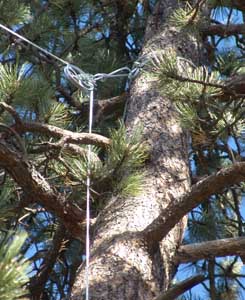 The
idea of mounting the wire dipole antenna was to have the two outer ends attached to the upper
part of trees conveniently located. The
idea of mounting the wire dipole antenna was to have the two outer ends attached to the upper
part of trees conveniently located.
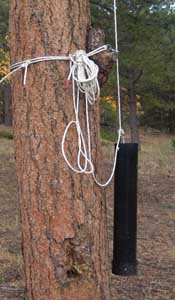 To
facilitate the access to the wires, I attached a pulley to the trunk and ran
the rope from the end of the antenna over the pulley down the tree trunk and
attached it to a tube filled with rocks. This way the antenna could stretch
and the tree could move without tearing each other apart. To
facilitate the access to the wires, I attached a pulley to the trunk and ran
the rope from the end of the antenna over the pulley down the tree trunk and
attached it to a tube filled with rocks. This way the antenna could stretch
and the tree could move without tearing each other apart. |
|
For the antenna wire, my choice after
evaluating a large number of options, was unshielded #14 WG aircraft
(MIL) grade wire which is a tin-plated stranded copper wire with Tefzel insulation.
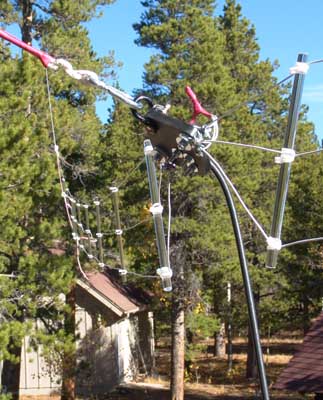 When
building my aircraft I found this wire and it's insulation to be extremely tough
but good to handle. When
building my aircraft I found this wire and it's insulation to be extremely tough
but good to handle.To
keep the wires spaced, I used Plexiglas rods with tie-wraps to attach the
wire. This way I could slide the spacers along the wire when adjusting them
at tuning. I am aware that at an altitude of 9000 ft, the UV light would do it's
job in damaging the integrity of some of the plastic. However, I was sure
that I would eventually do some modifications. |
|
|
|
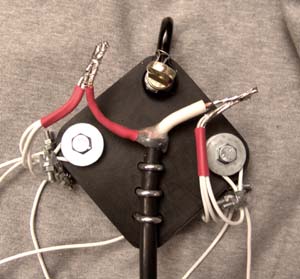 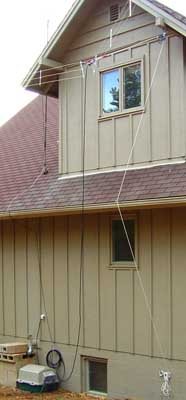 The
feed point for the three dipoles is made of a solid square chunk of plastic,
capable of taking the tension and load of the antenna construction and
feeding coaxial cable. The ends of all the wires were sealed with the trusty
glue gun and shrink tubing if necessary. The whole element was also
suspended from a pulley to permit lowering. The
feed point for the three dipoles is made of a solid square chunk of plastic,
capable of taking the tension and load of the antenna construction and
feeding coaxial cable. The ends of all the wires were sealed with the trusty
glue gun and shrink tubing if necessary. The whole element was also
suspended from a pulley to permit lowering. |
As there is always
a chance of lightning, not uncommon in the mountains, I built one of
Rip's grounding contraptions.
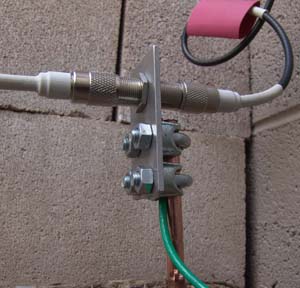 With
the coaxial cable coming from the antenna I first coiled the cable to create
an RF choke before attaching the feed to the grounding element [##2]. Of
course I had part of the coax coming from the feed point radiating as part
of the antenna before the choke took effect. With
the coaxial cable coming from the antenna I first coiled the cable to create
an RF choke before attaching the feed to the grounding element [##2]. Of
course I had part of the coax coming from the feed point radiating as part
of the antenna before the choke took effect. |
|
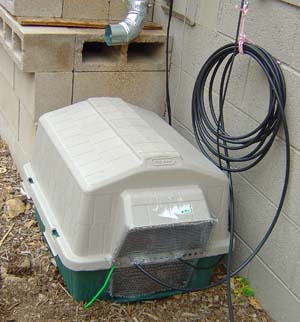 The
feed point of the antenna cable into the house is on the back side of the
house, generally protected from the weather. The winds however, can come
from all directions and it is not uncommon in winter to have the snow
stacked up against the house. To avoid water entering the connectors or the
cable ends I found a suitable little dog house, cut away the bottom and anchored
it over the grounding rods. The front where the dog normally enters is
closed off with a metal screen in order not to invite any wild mountain
residents as a winter home and also to ground any lightning. The grounding rod
and the screen is connected to a grounding wire leading away from the house
into more moist soil and anchored to tree further rods driven into the
ground. The
feed point of the antenna cable into the house is on the back side of the
house, generally protected from the weather. The winds however, can come
from all directions and it is not uncommon in winter to have the snow
stacked up against the house. To avoid water entering the connectors or the
cable ends I found a suitable little dog house, cut away the bottom and anchored
it over the grounding rods. The front where the dog normally enters is
closed off with a metal screen in order not to invite any wild mountain
residents as a winter home and also to ground any lightning. The grounding rod
and the screen is connected to a grounding wire leading away from the house
into more moist soil and anchored to tree further rods driven into the
ground. |
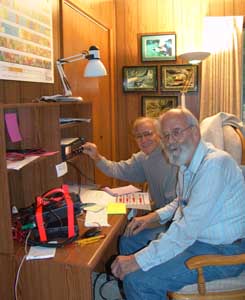 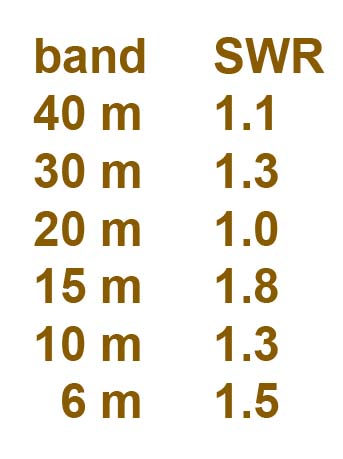 Finally,
it took me a few days to adjust the length of the various wires to resonate
optimally on the amateur HF bands (before the antenna tuner). My guide and
friend, Rip was a great help to suggest
all those little details as only an old "Pro" would know and spot. Finally,
it took me a few days to adjust the length of the various wires to resonate
optimally on the amateur HF bands (before the antenna tuner). My guide and
friend, Rip was a great help to suggest
all those little details as only an old "Pro" would know and spot.
|
|
|
|
##2 see ARRL Handbook, chapter
21 "Transmission Lines" |


